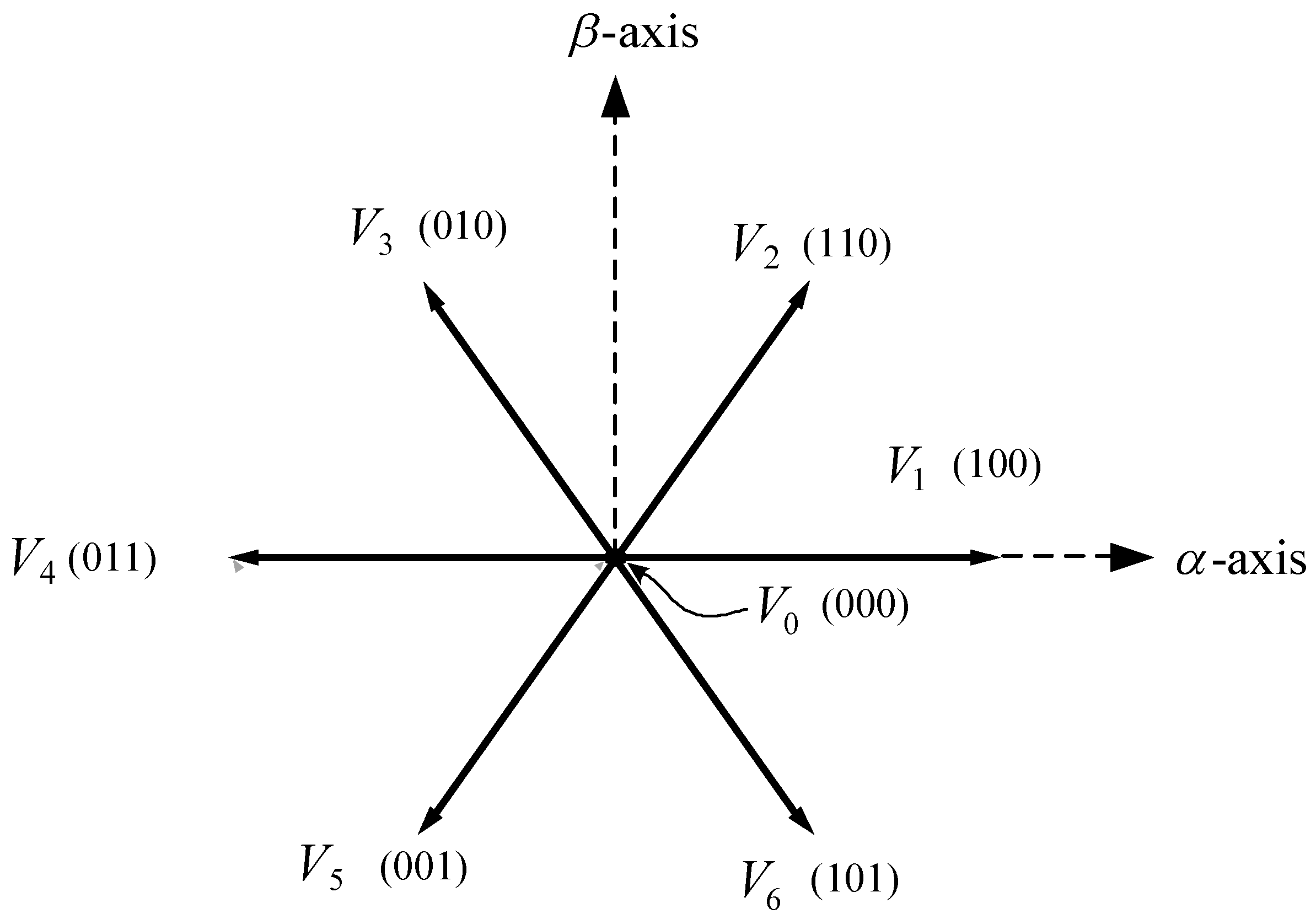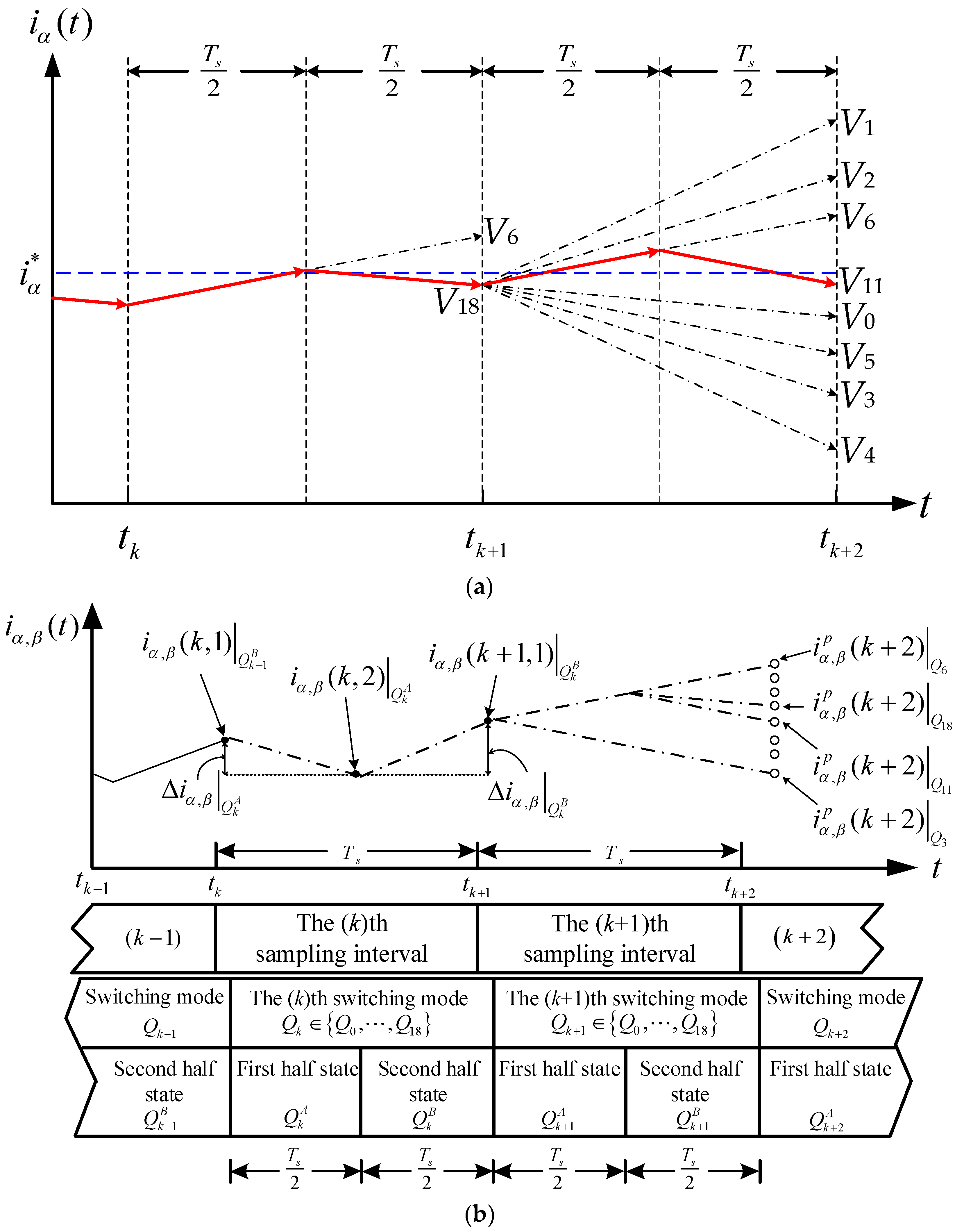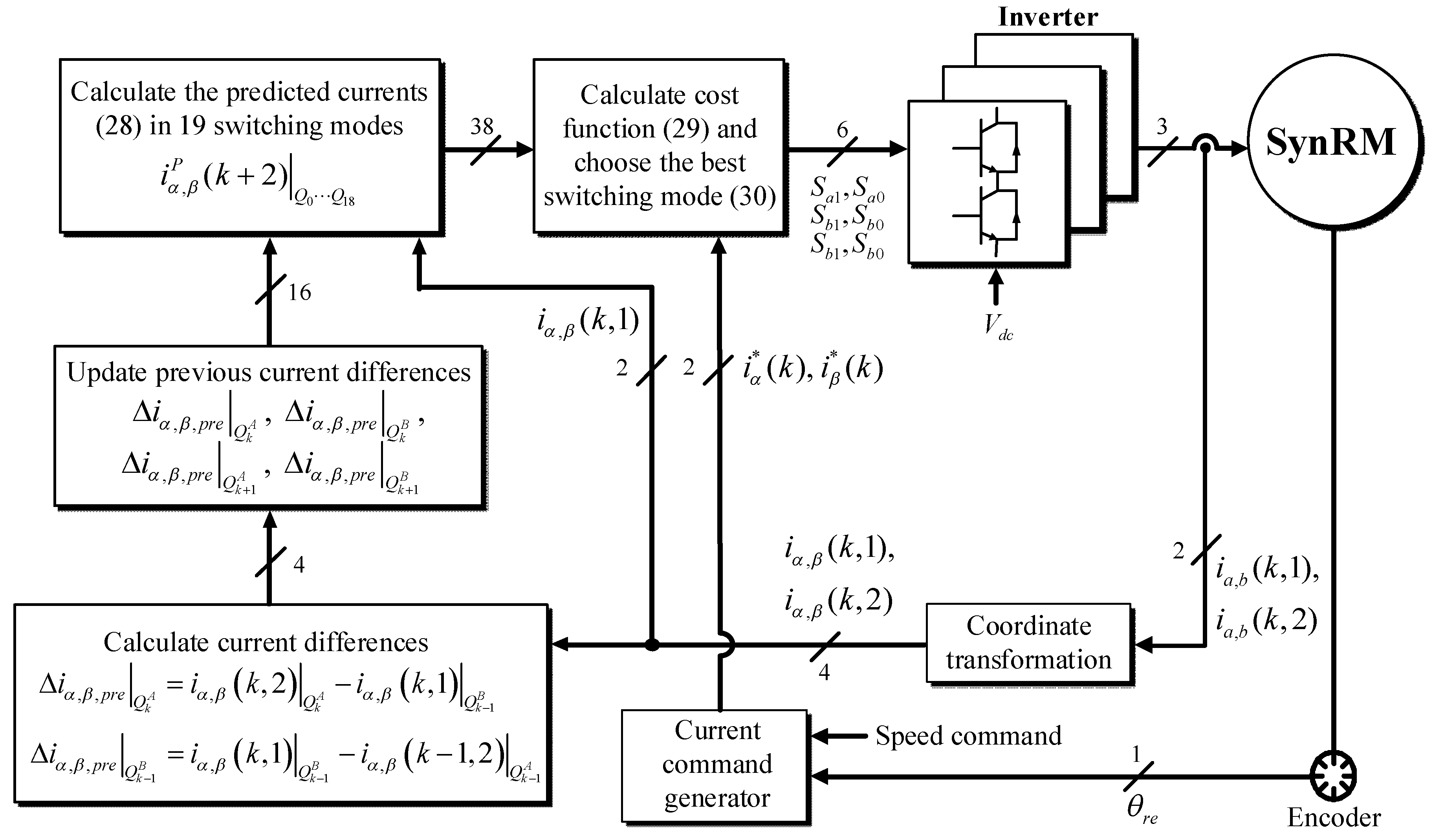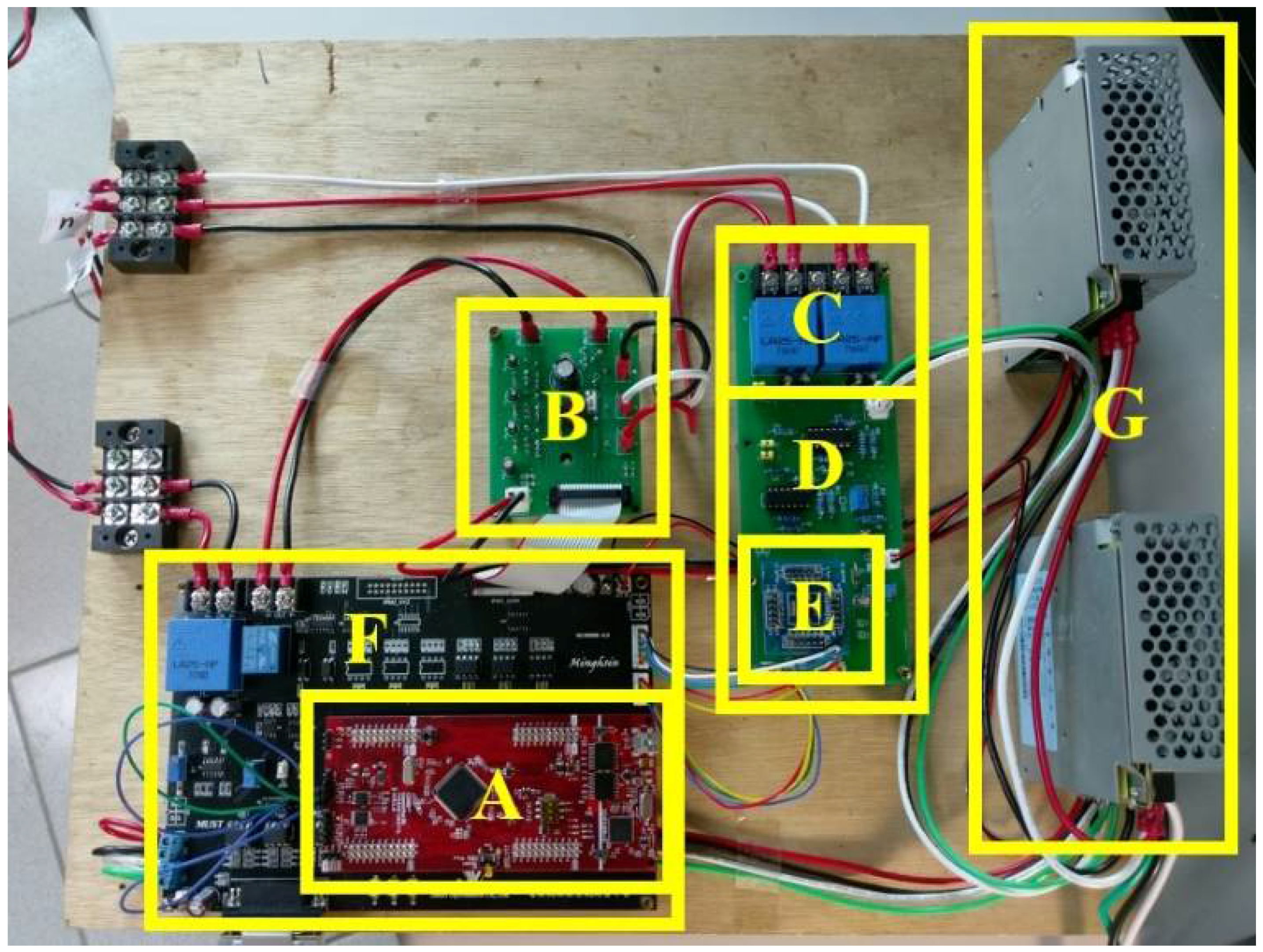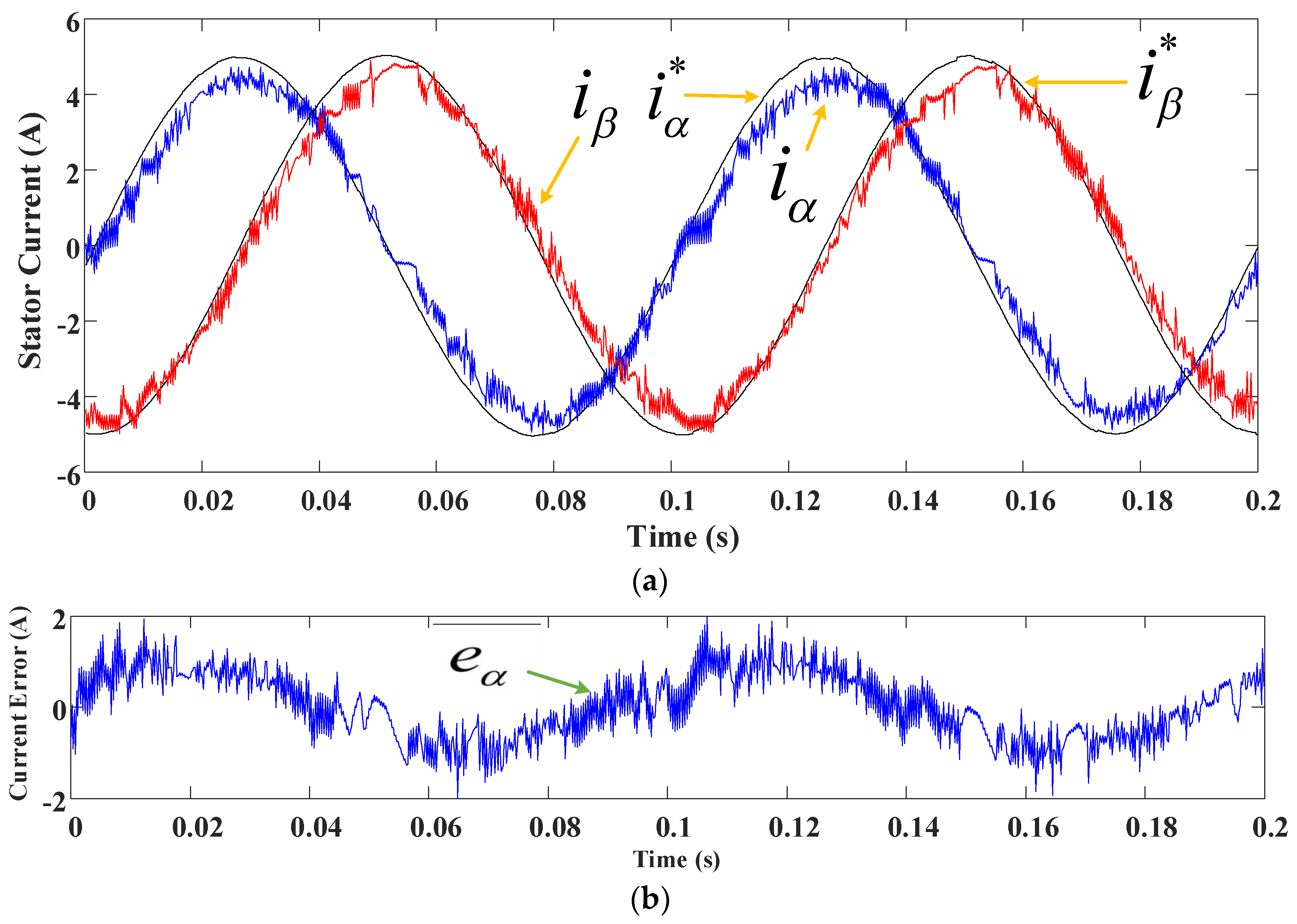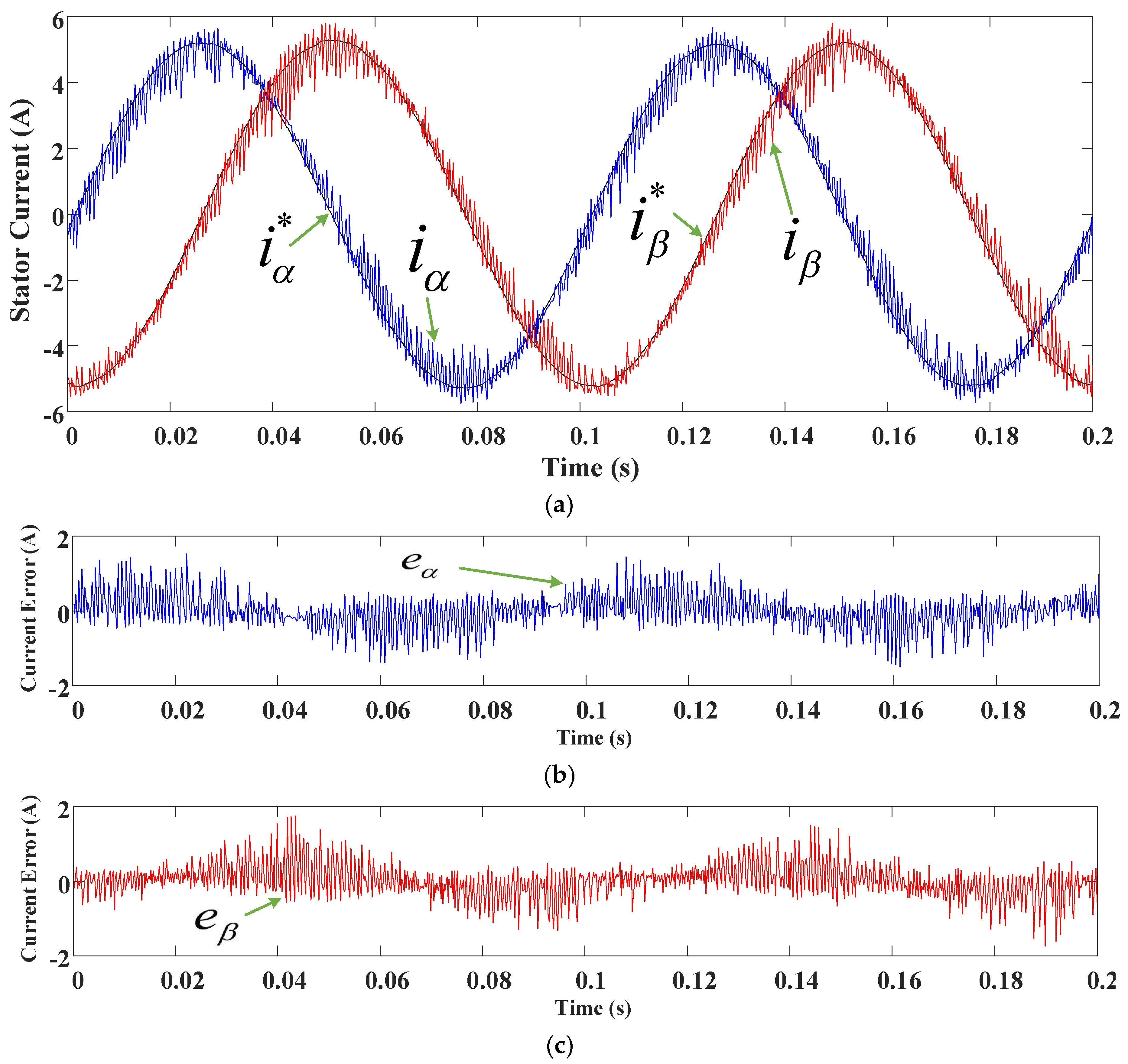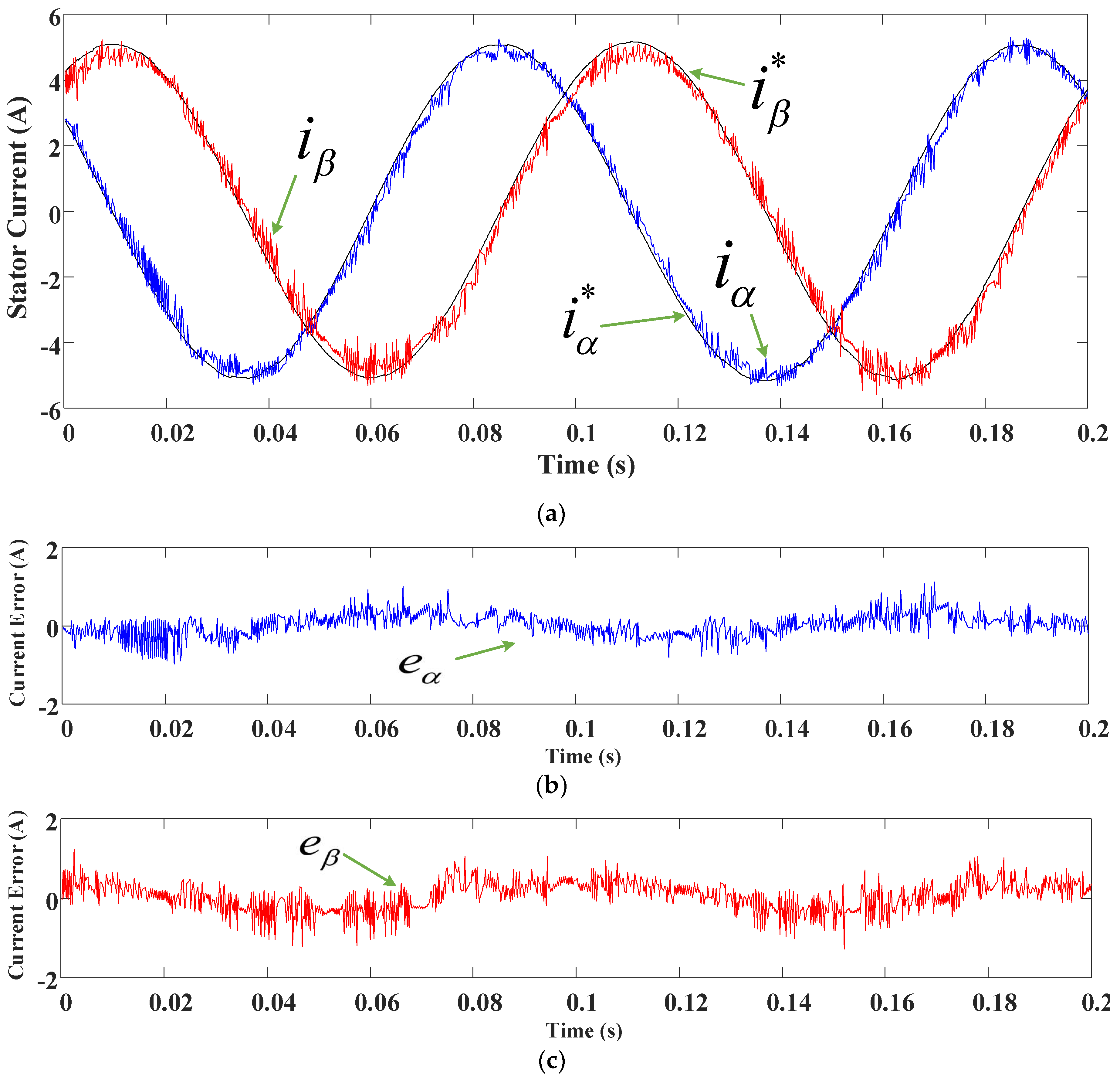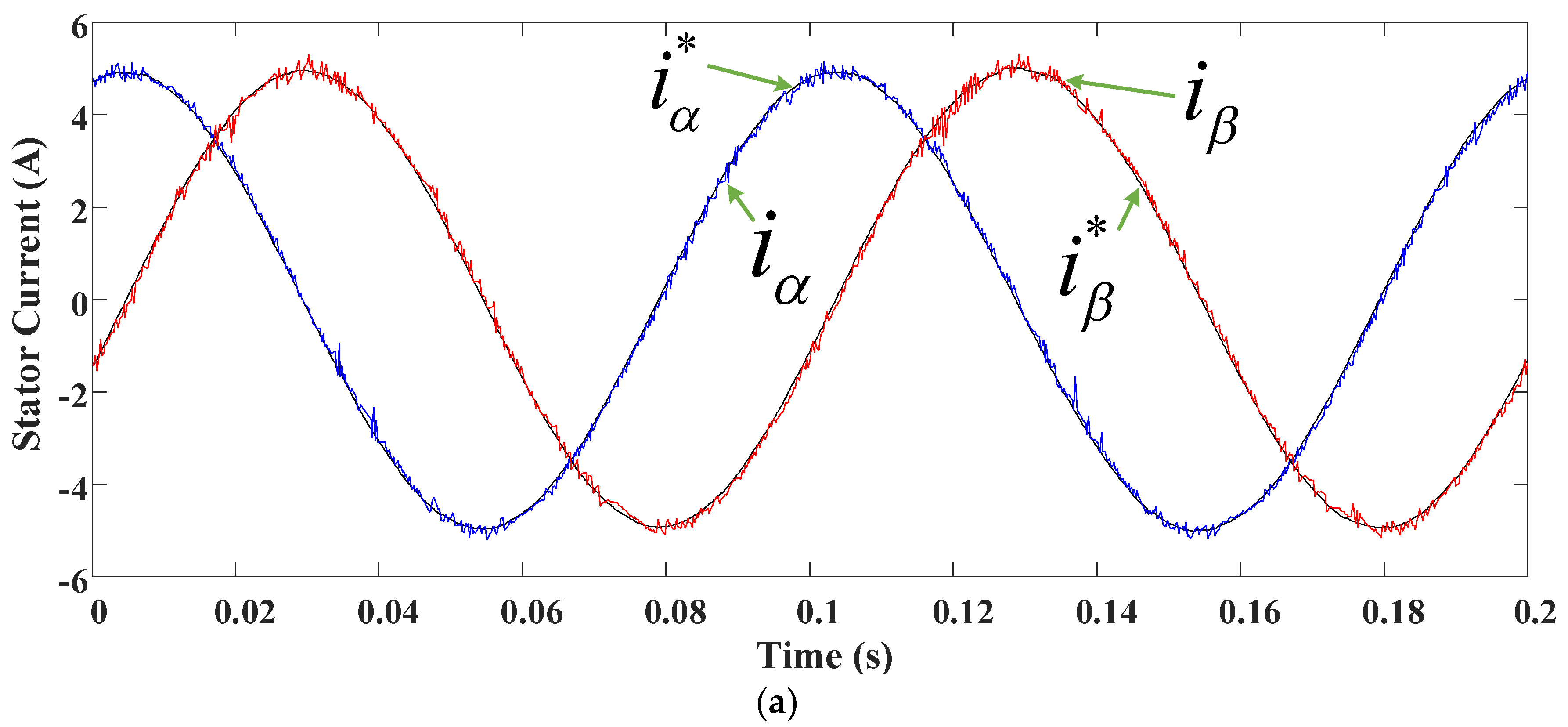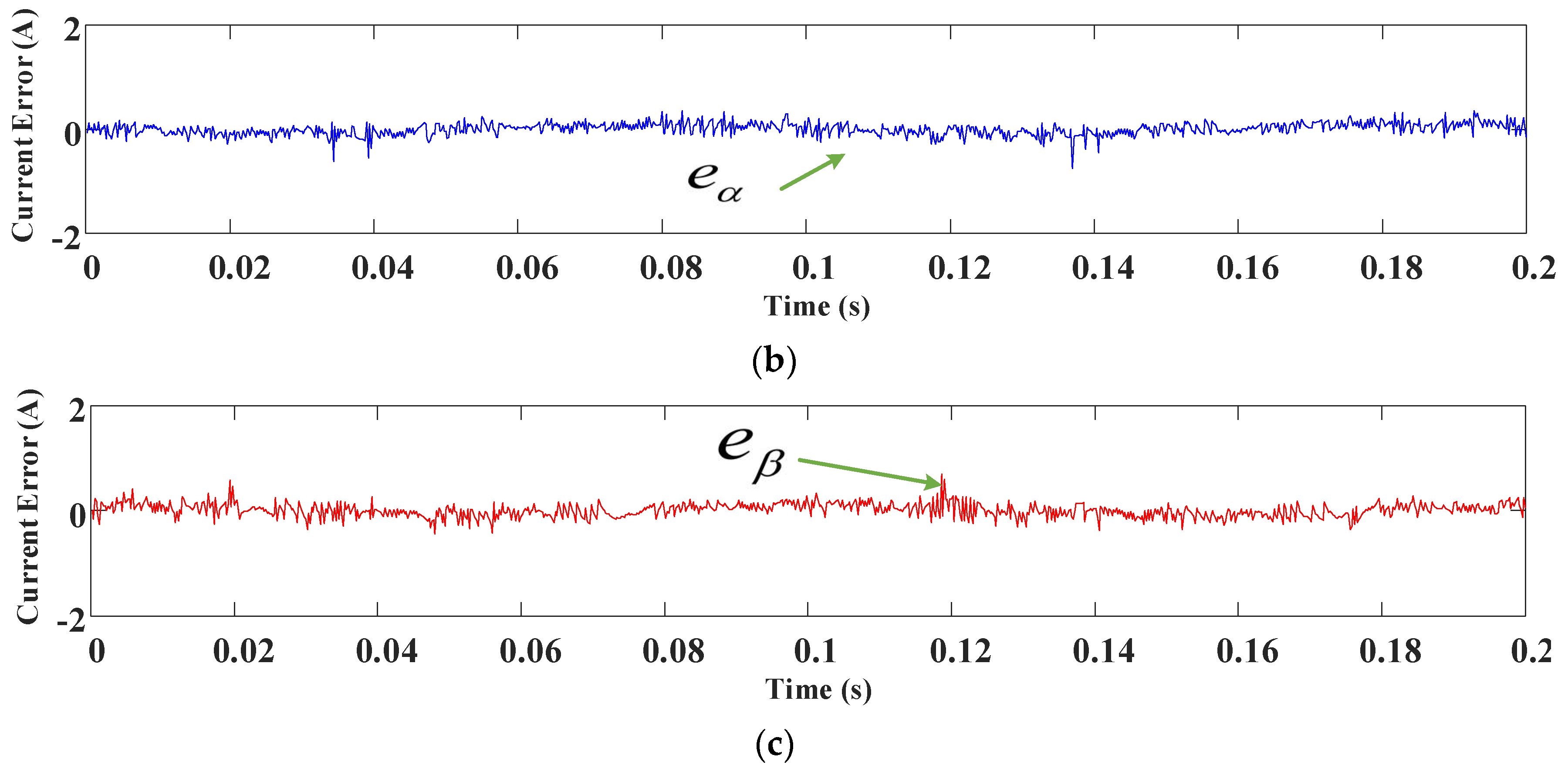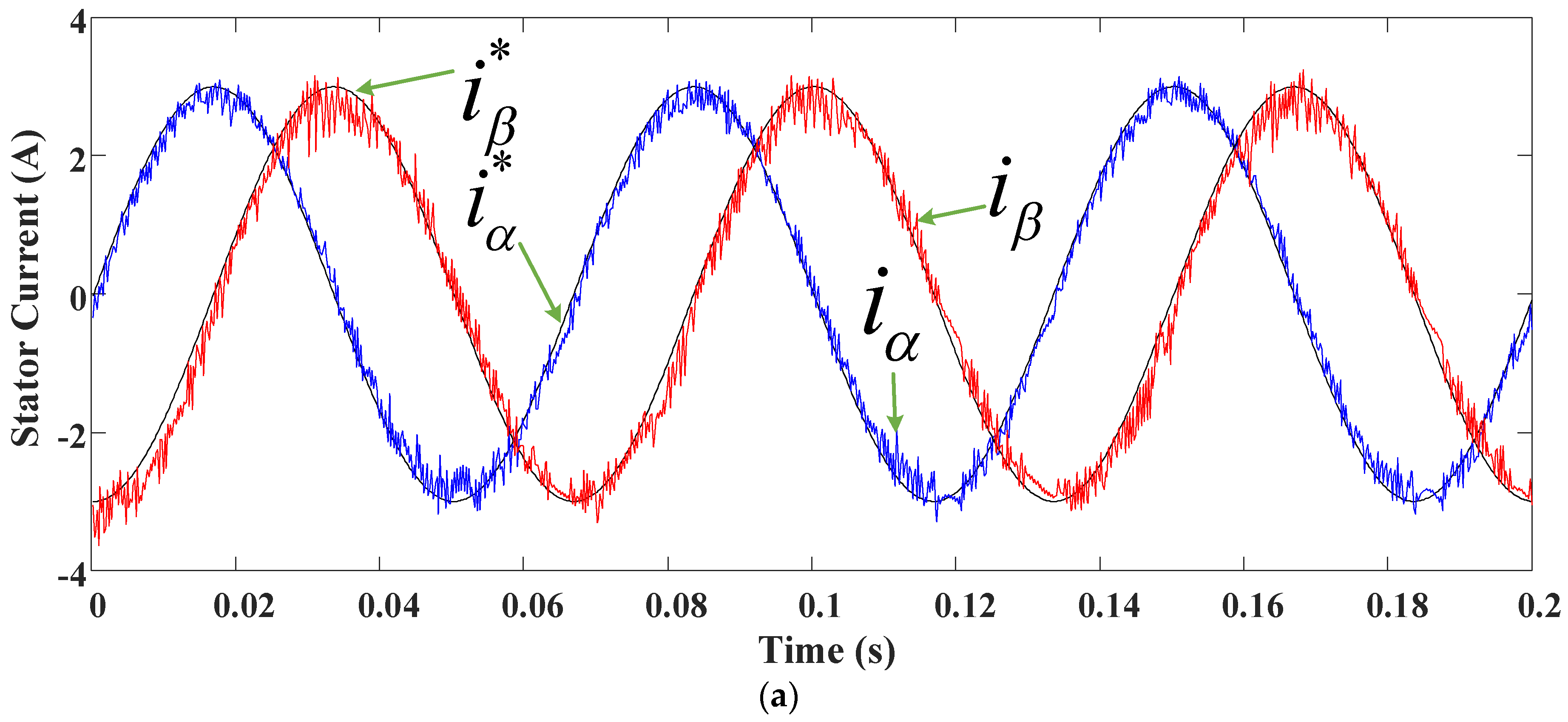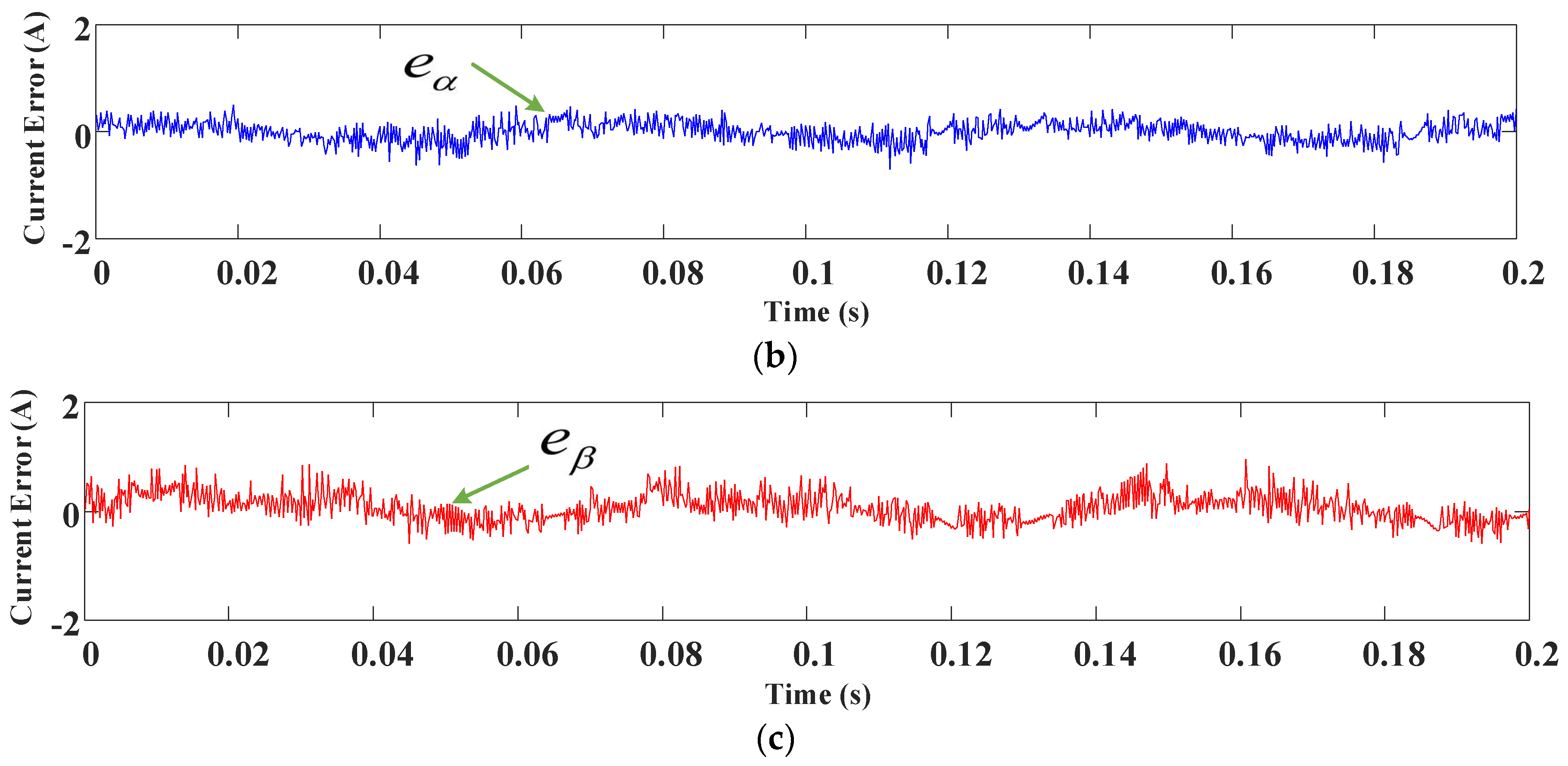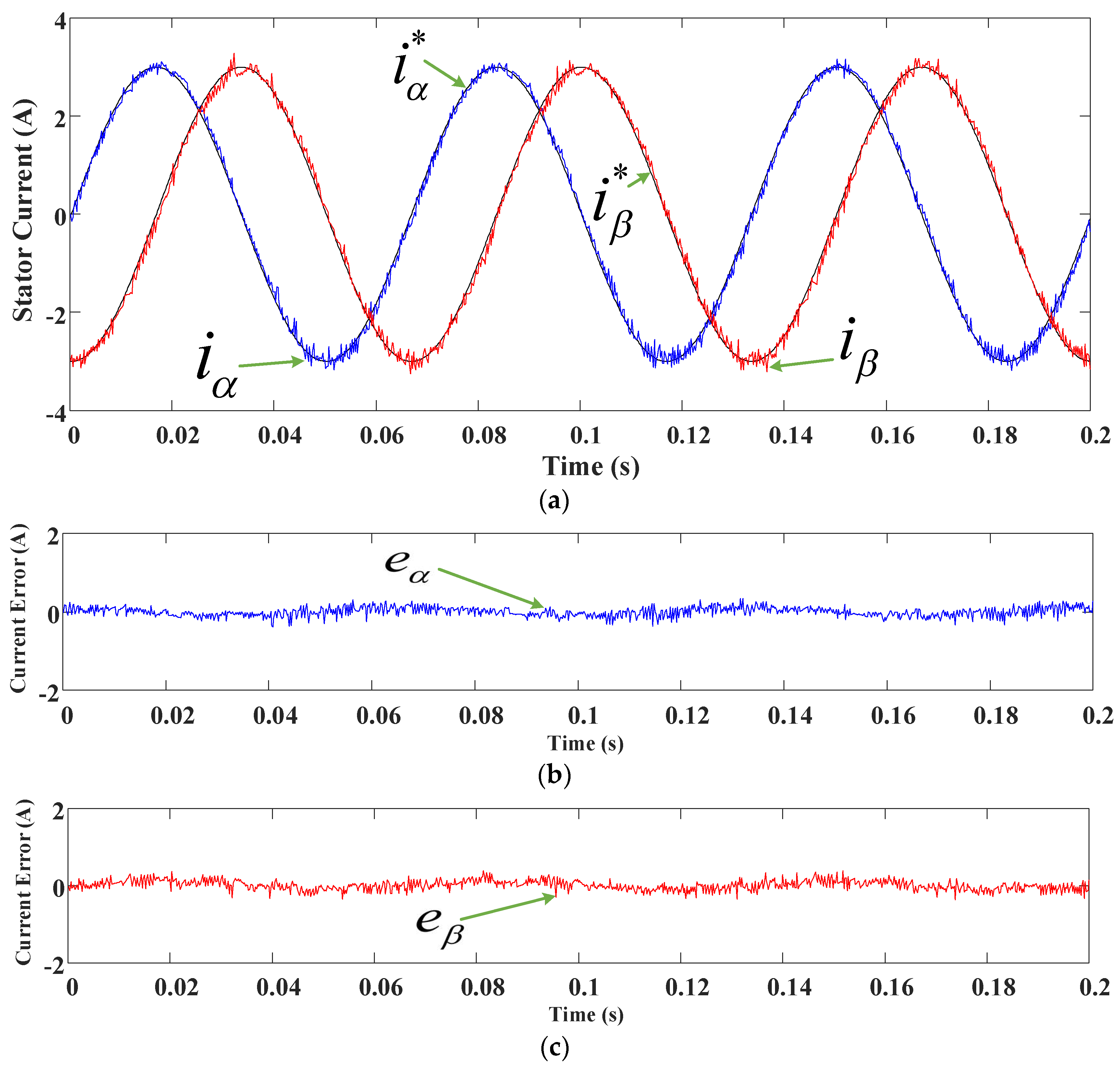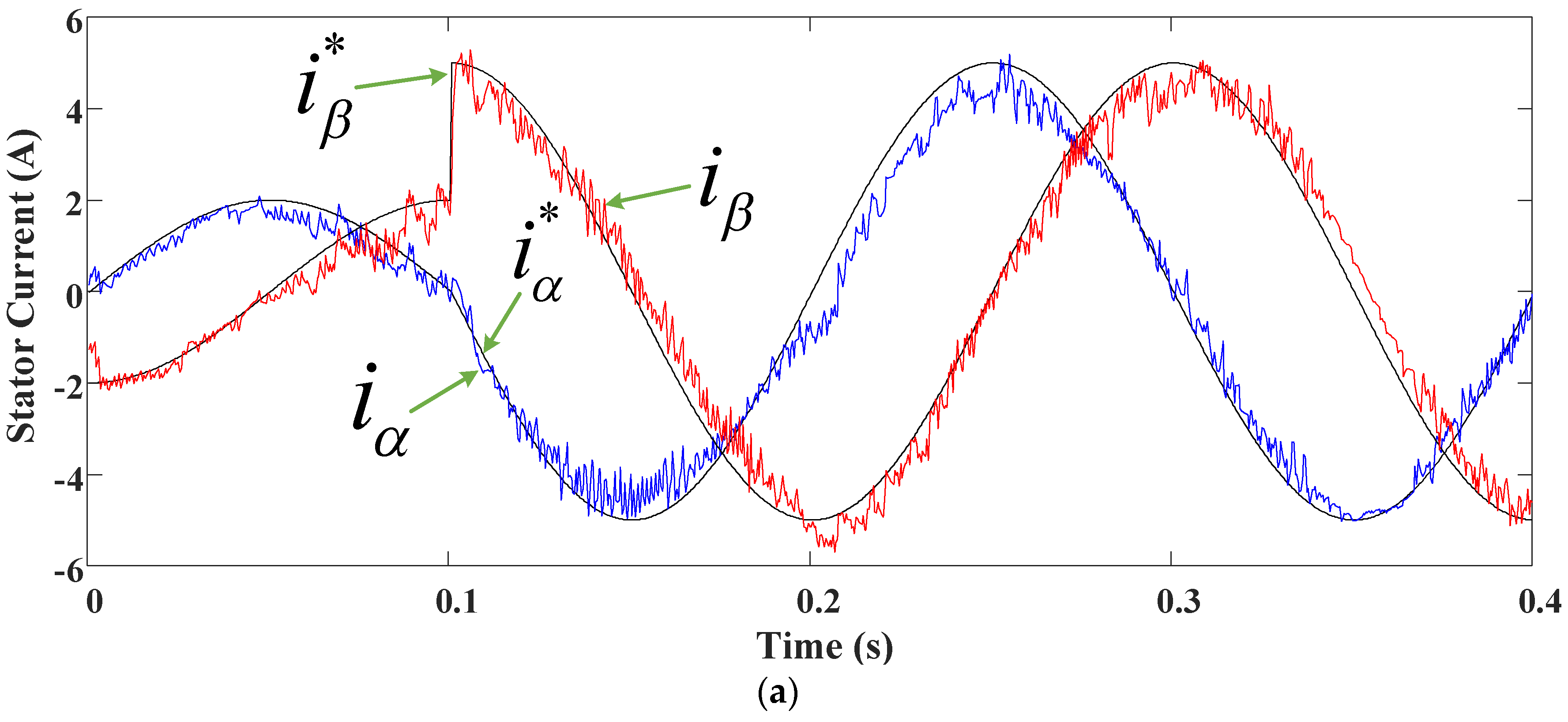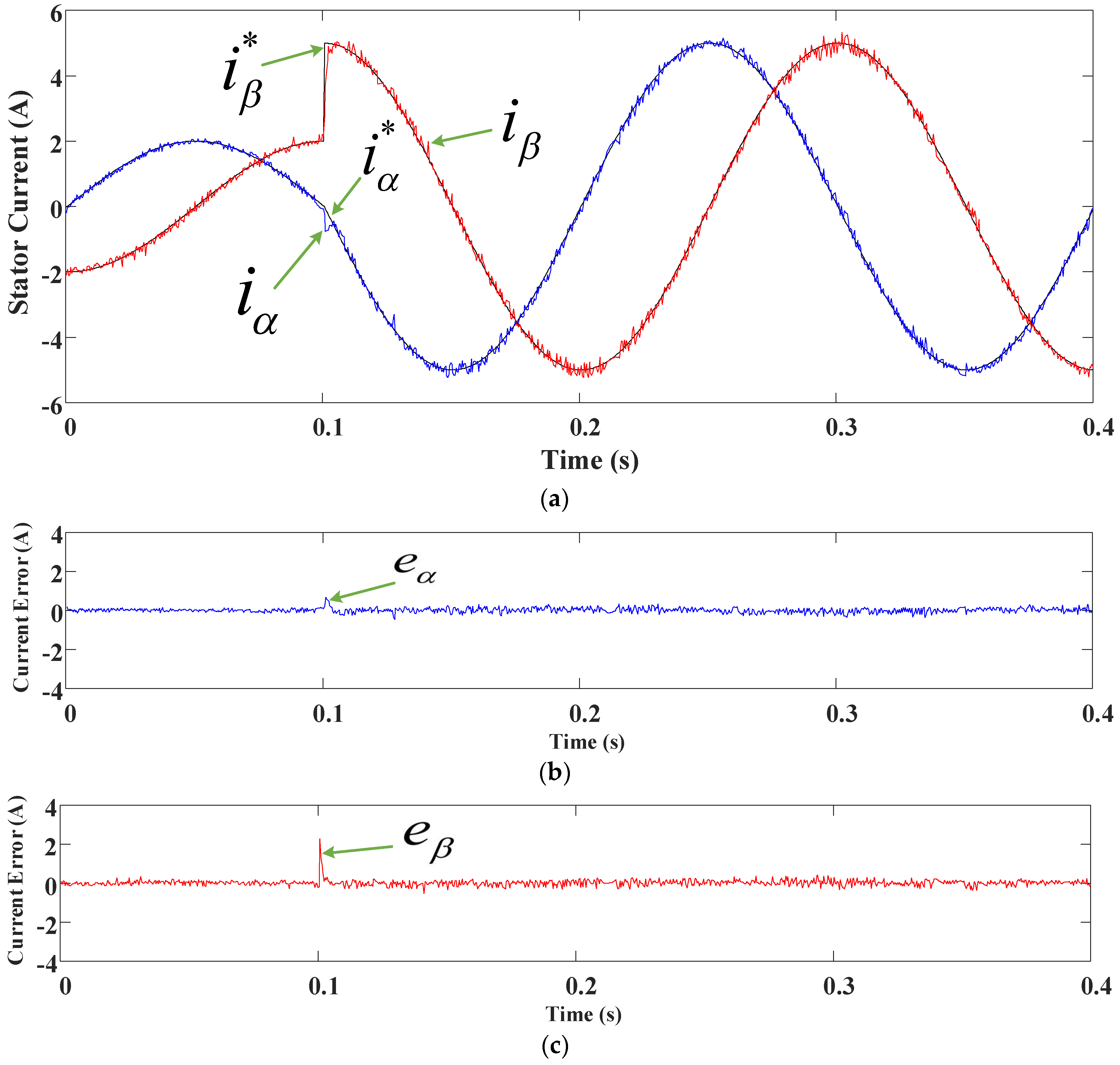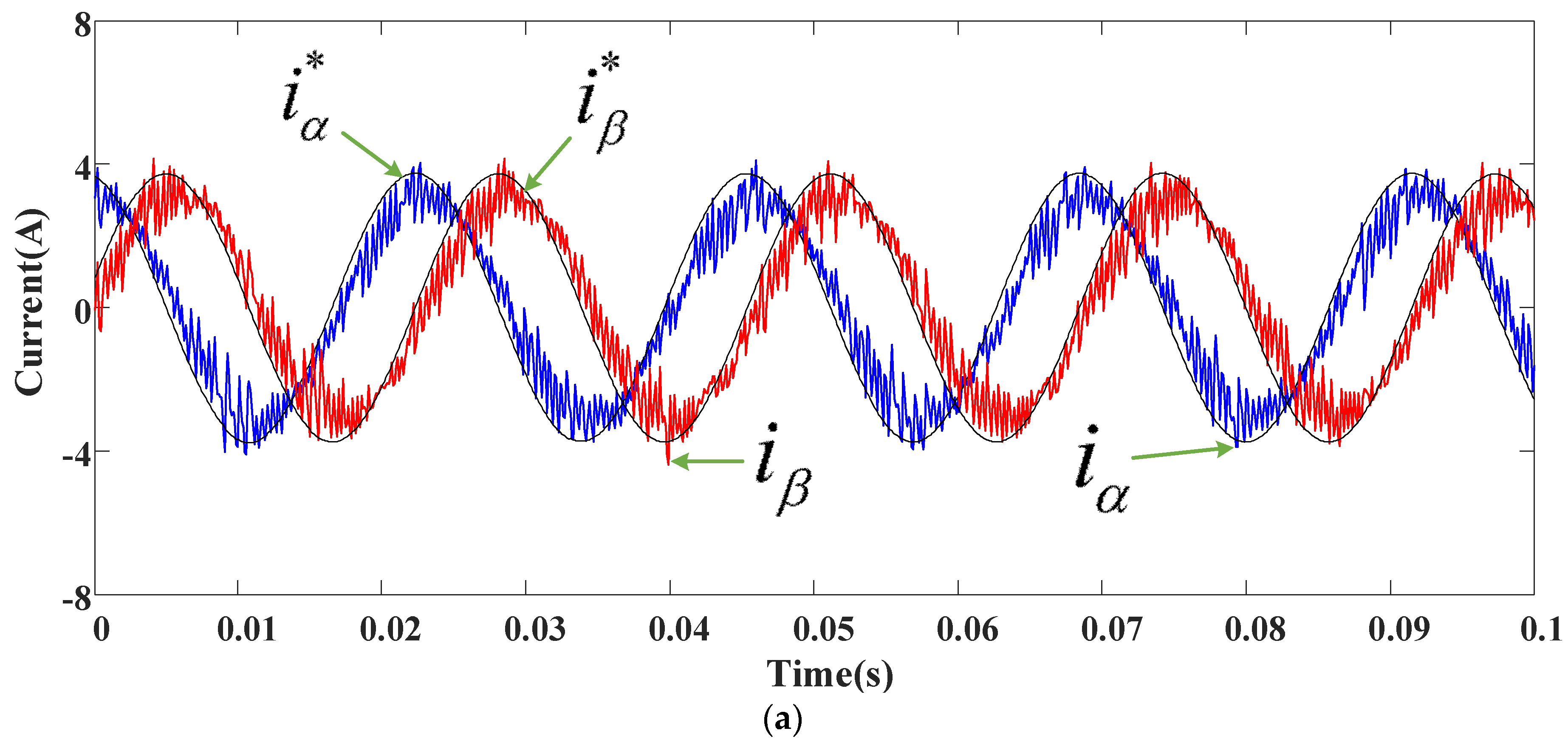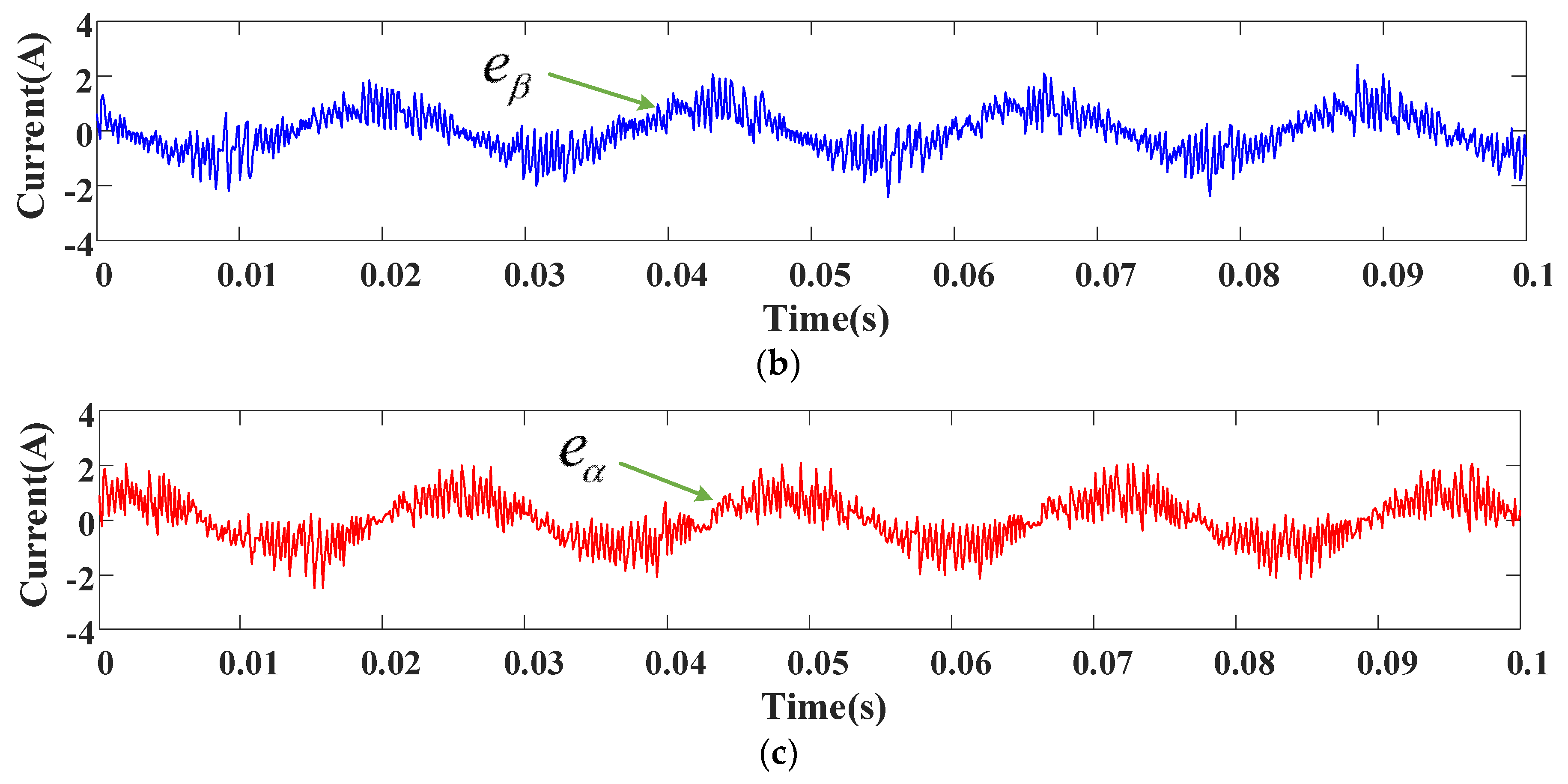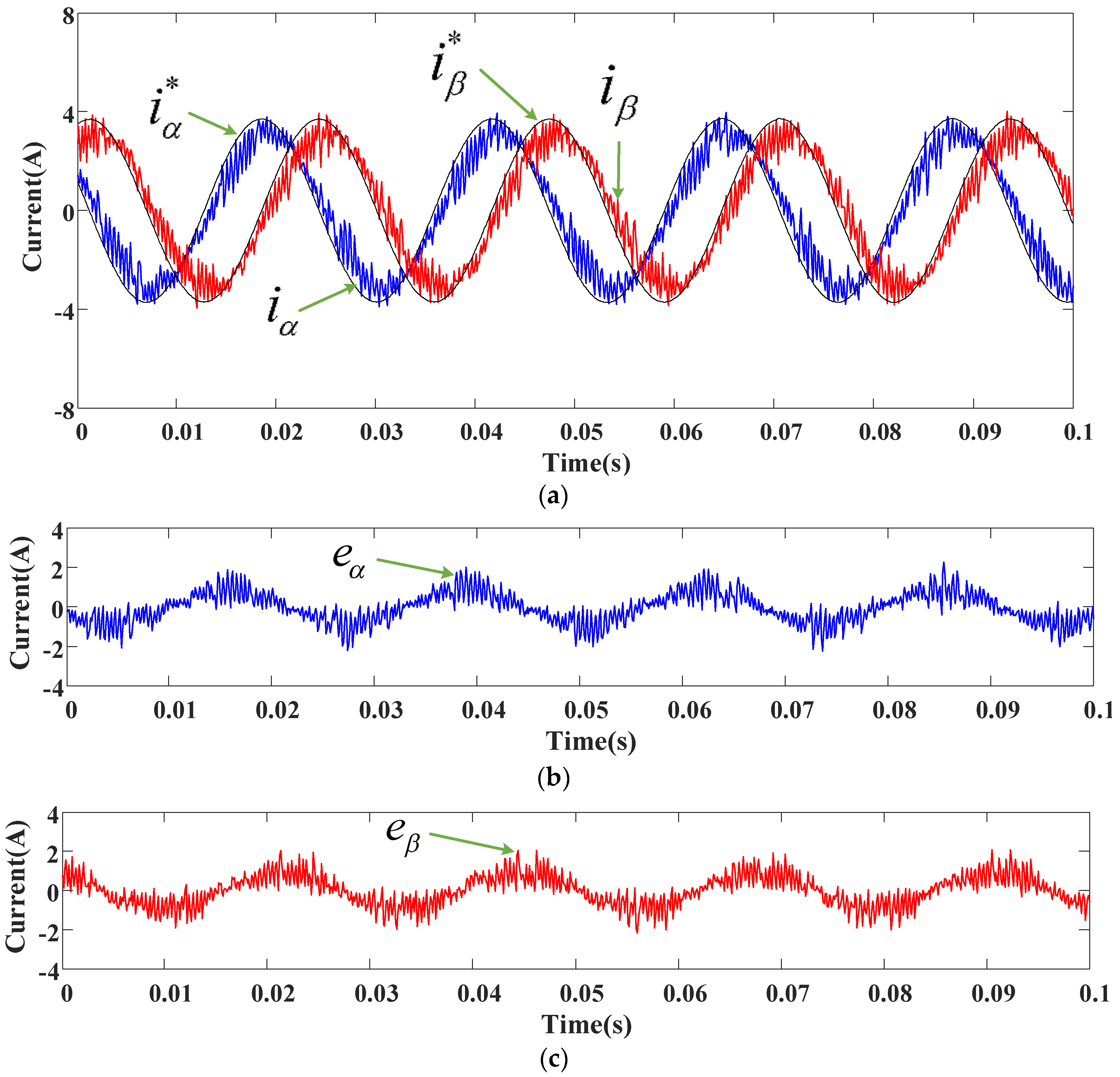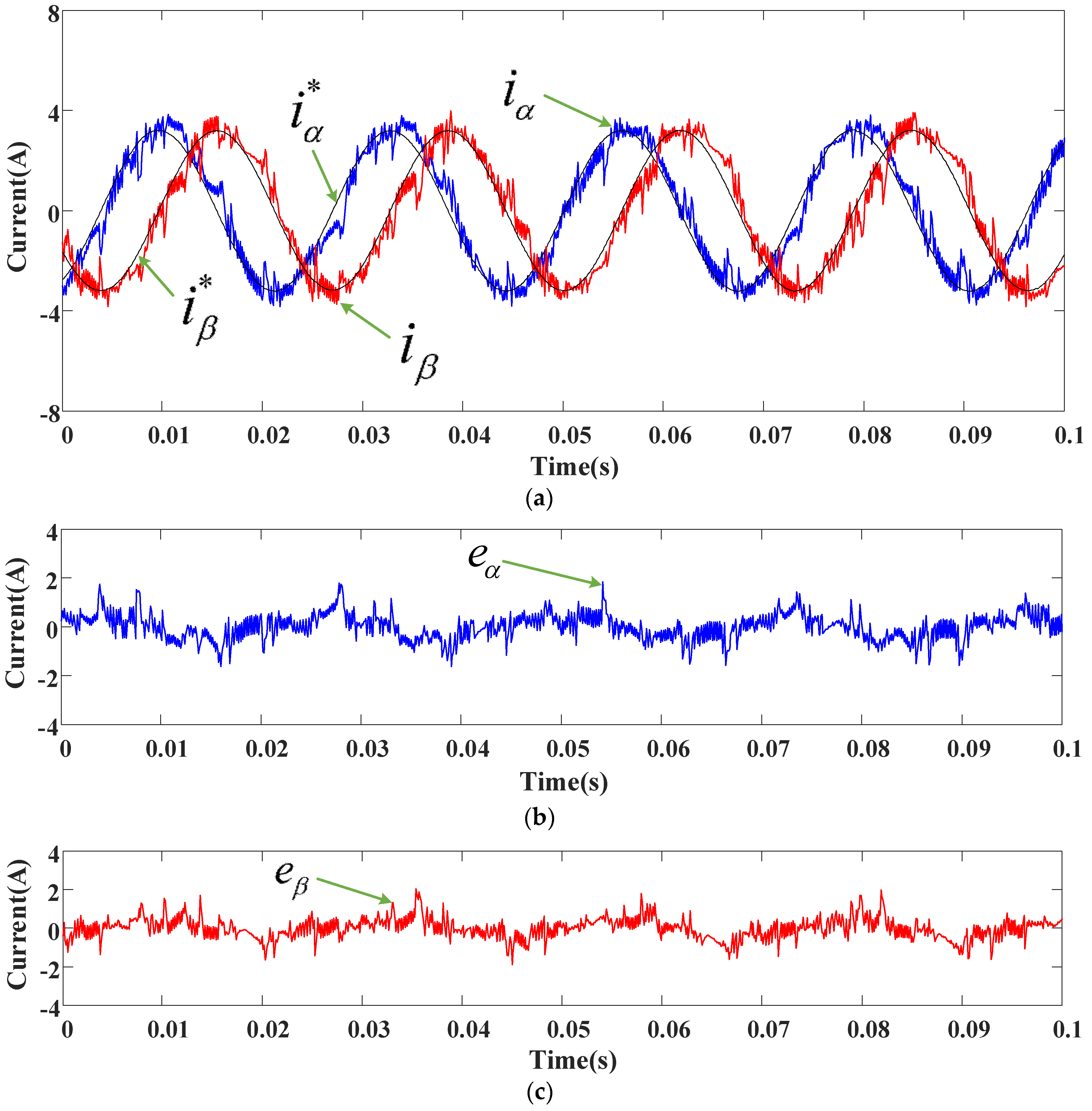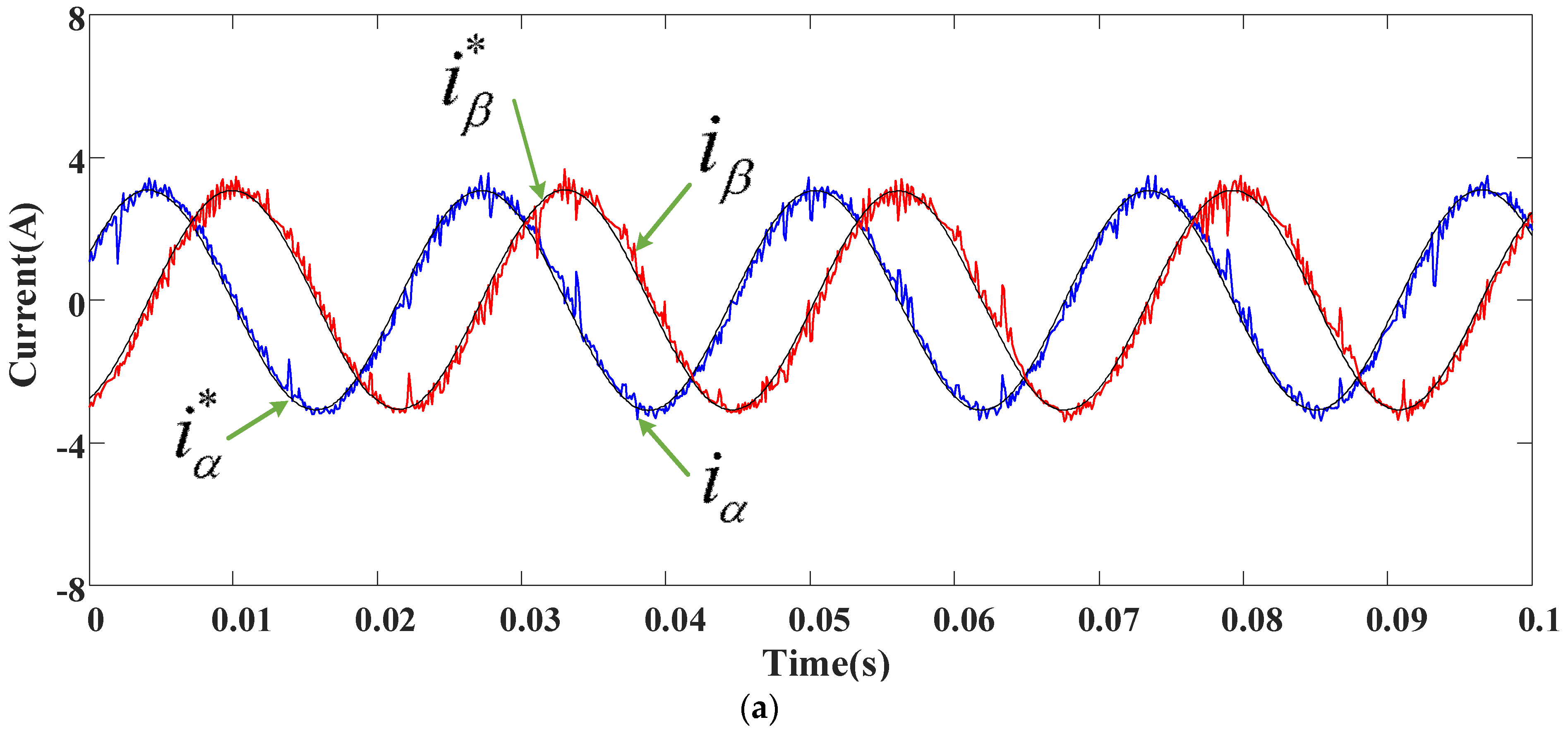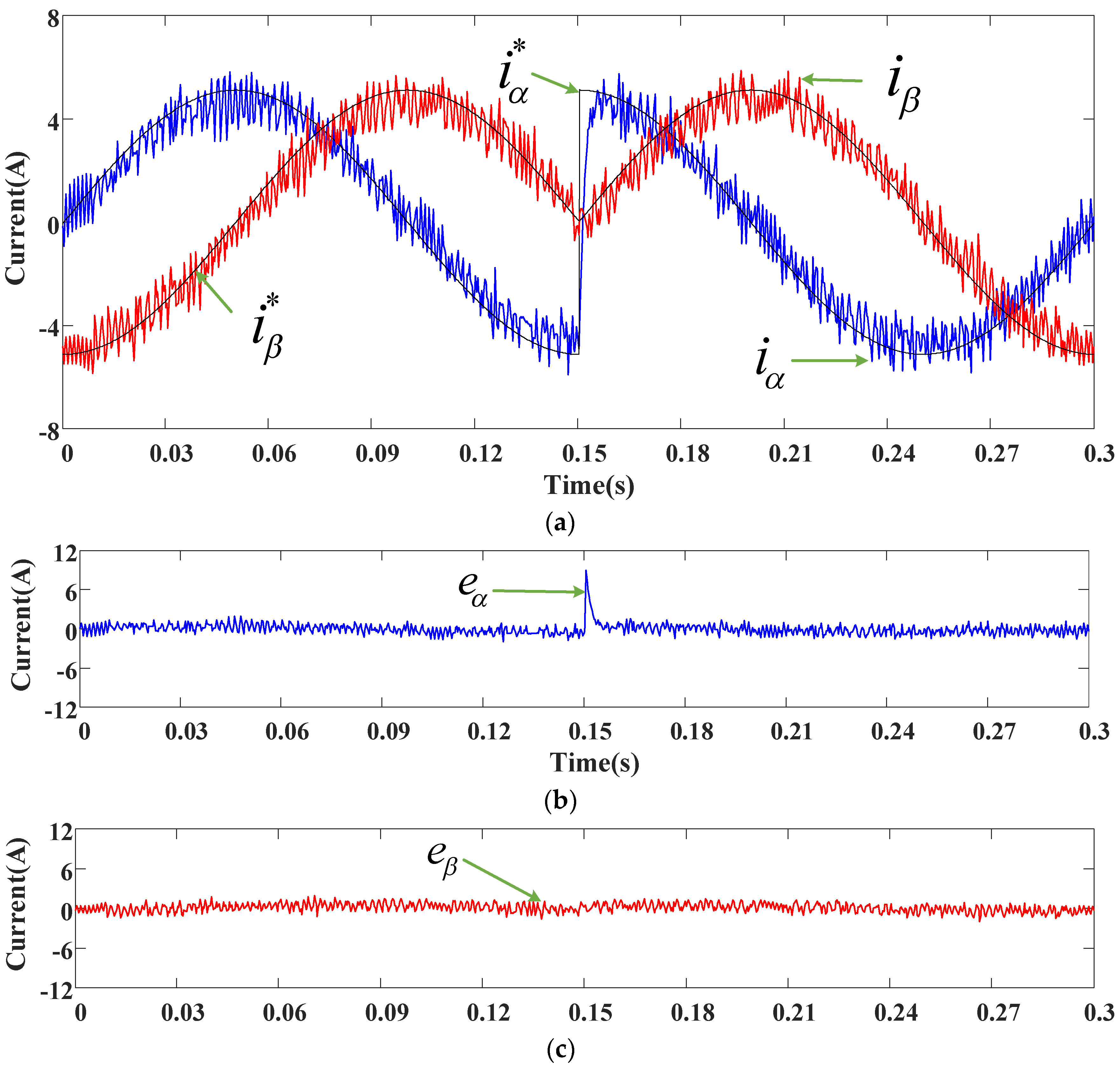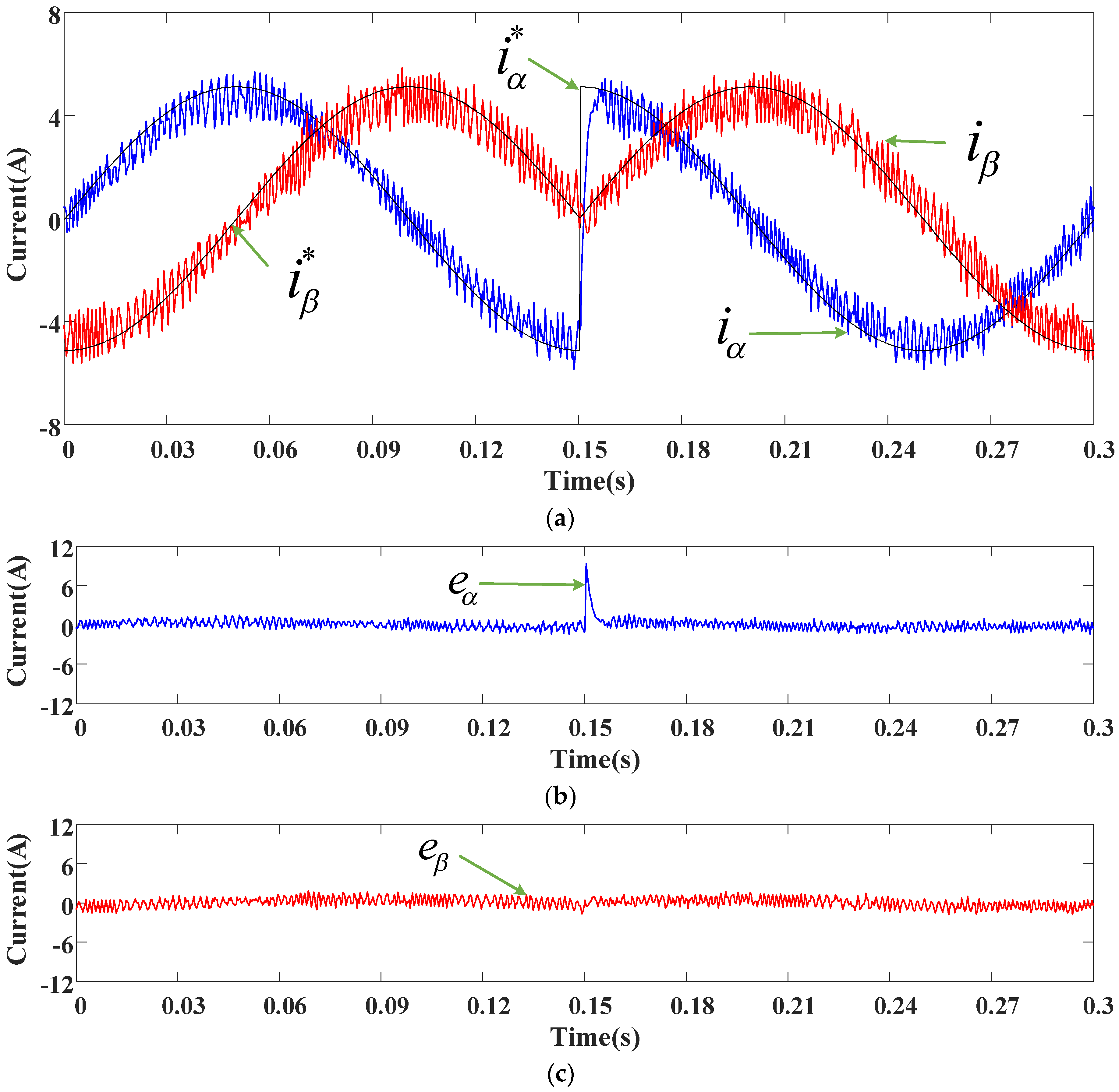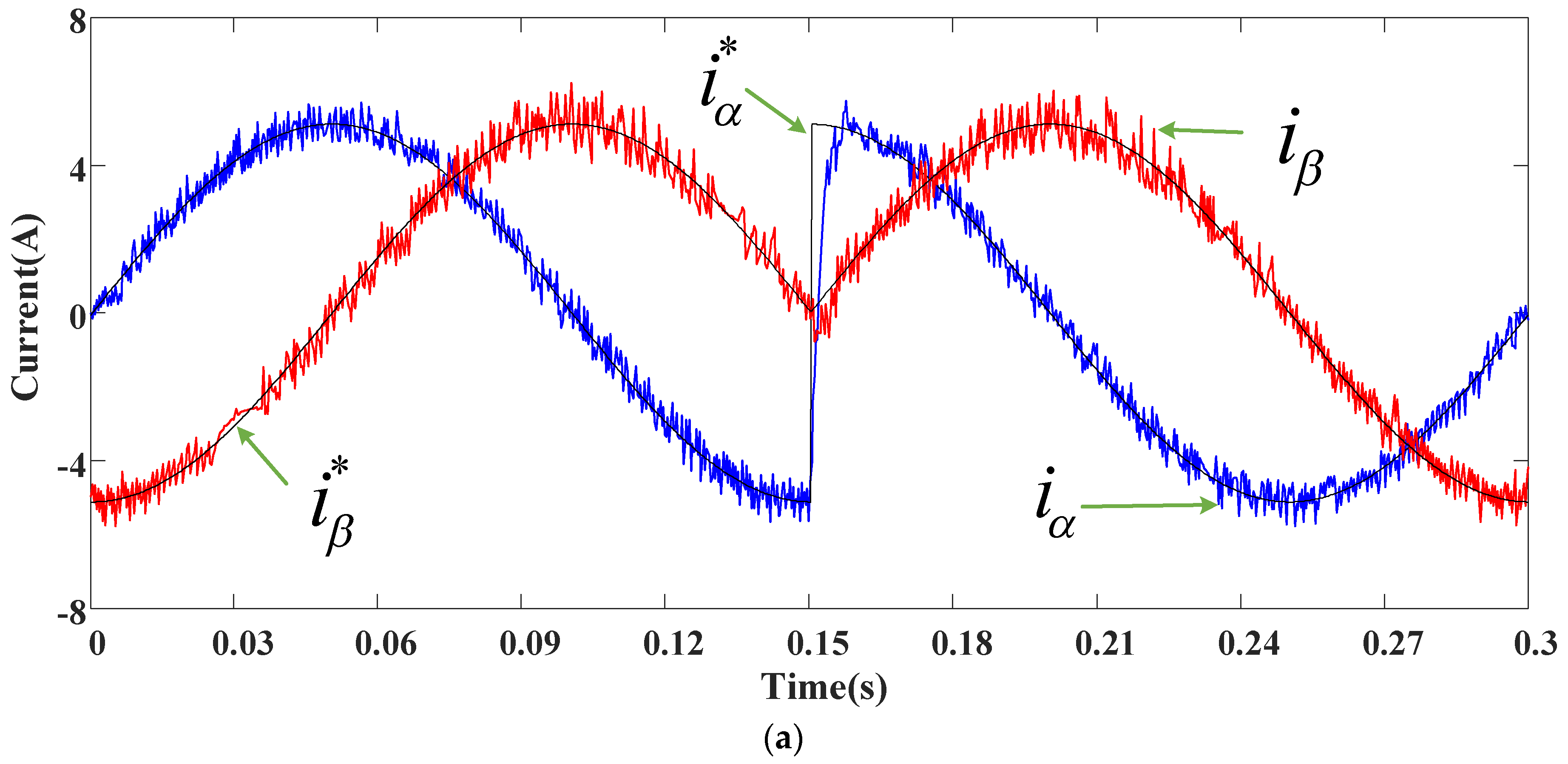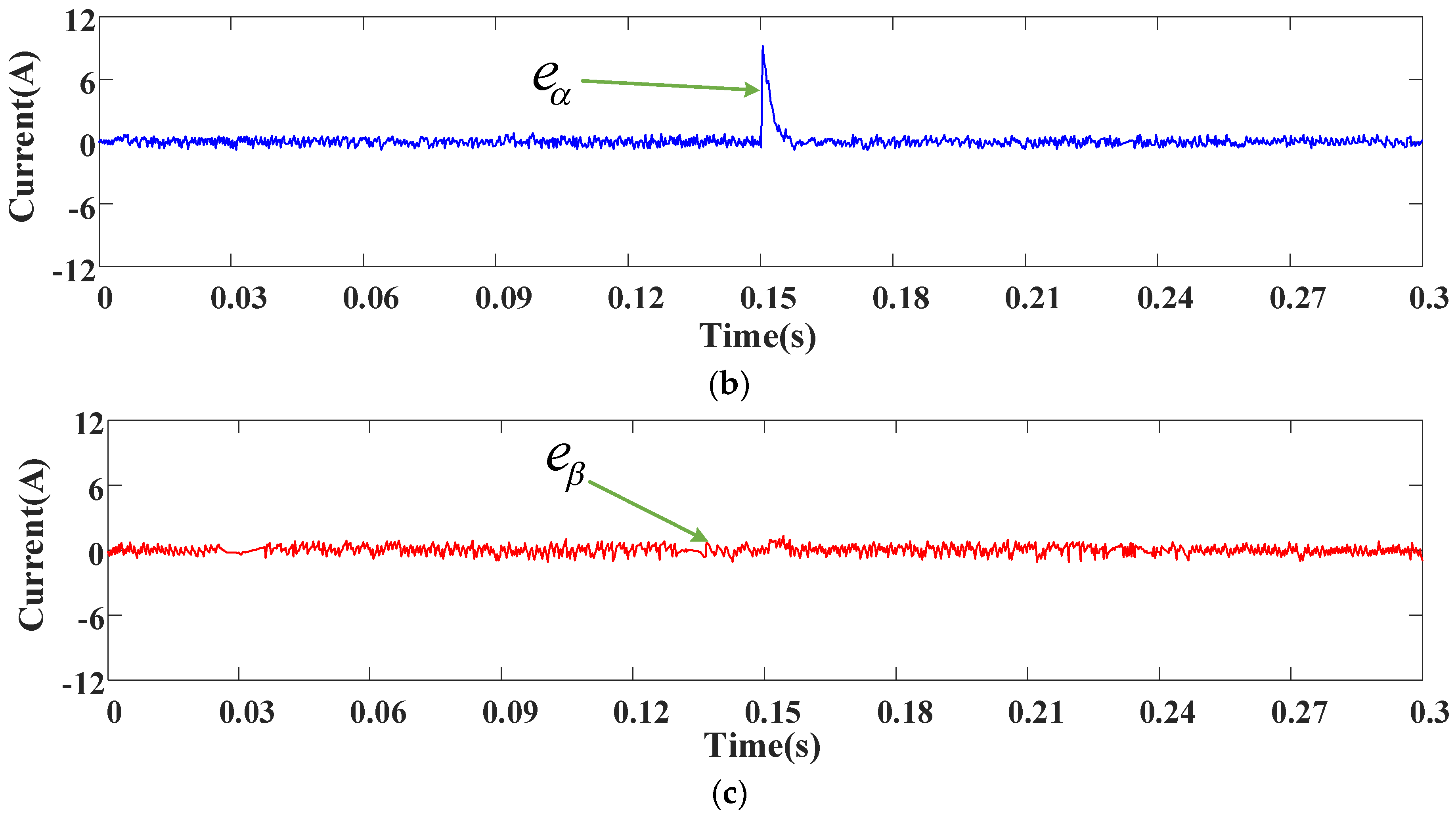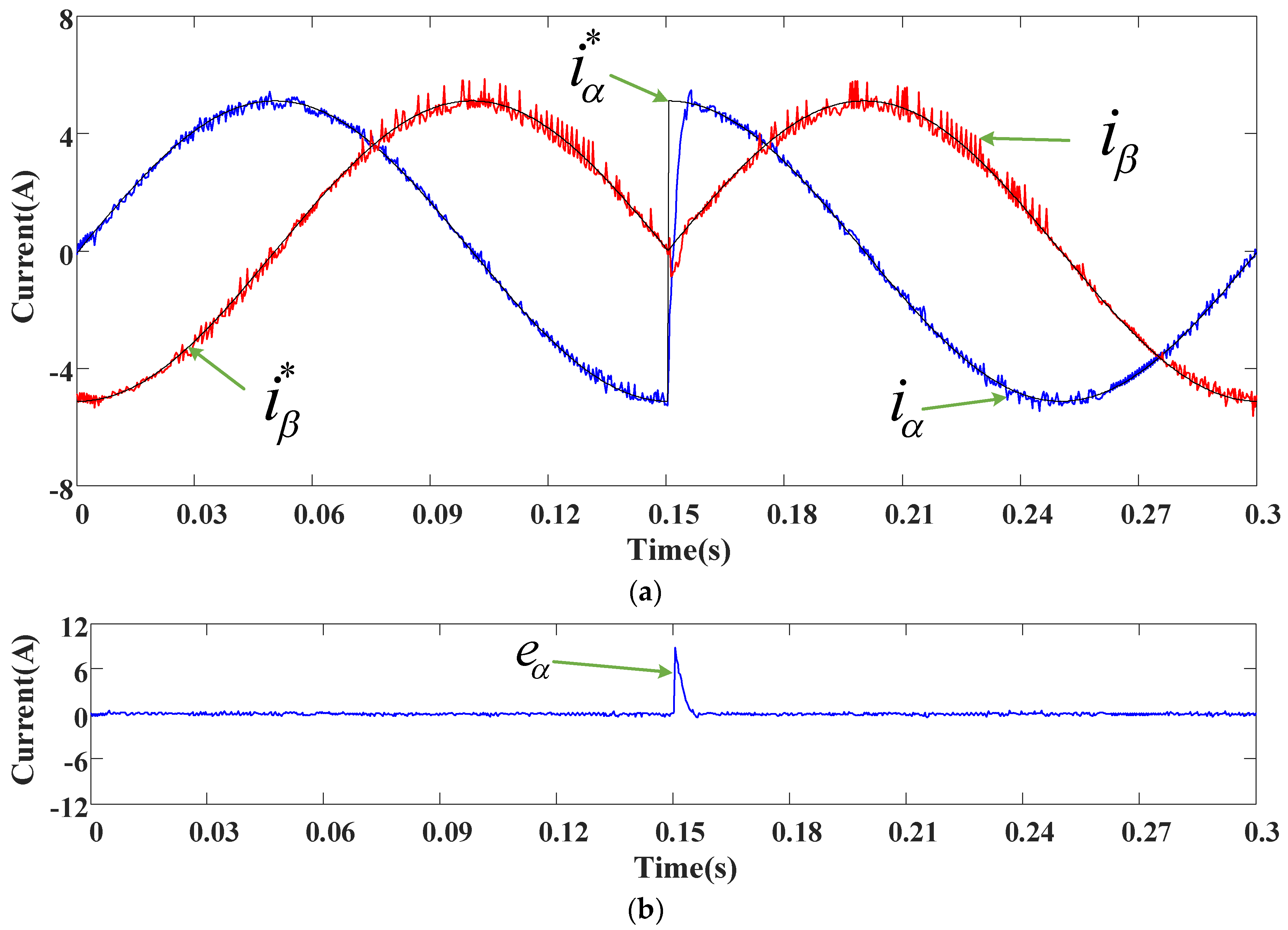With an appropriate device [
1], fuel energy can be converted into mechanical/kinetic energy. In comparison to that process, electric motors are used to convert electrical energy into mechanical/kinetic energy. Among various motor types, the synchronous reluctance motors (SynRMs) have been widely used in washing machines, air conditioners, and electric vehicles thanks to their robustness, simple structure, and without use of magnetic materials. In order to achieve high performance so as to save energy/power under different operation conditions, many current control methods have been developed in the past, such as hysteresis current control [
2], pulse width modulation (PWM) [
3], space vector PWM (SVPWM) [
4], and model predictive current control (MPCC) [
5,
6]. The first two methods, as limited by their nature, cannot predict future current in next sampling period. To date, a lot of research results in predictive current controllers have been reported and applied to motor drive systems and other applications. In addition to the MPCC, other model predictive control techniques and related applications are thriving as well. For example, a predictive control was applied to renewable energy systems [
7]. Nauyen and Kim [
8] proposed a modulated finite control set-model predictive control scheme for a grid-connected inverter under distorted grid conditions. Yang et al. [
9] proposed a predictive power control strategy for doubly fed induction generators (DFIGs) based on a wind energy converter system. Jin et al. [
10] presented a model predictive direct power control for nonredundant fault tolerant grid-connected bidirectional voltage source converter (BVSC). The proposed method was investigated for continuous operation in that paper, even if the BVSC has leg open-circuits faults. Guzmán et al. proposed a finite control set model predictive control for a three-phase shunt active power filter with a Kalman filter-based estimation [
11]. Using their method, the grid currents can be successfully controlled. In [
12], a model-based predictive current control (MBPCC) method with constant switching frequency was used to control the load current of a single-phase voltage source inverter. This method can generate switching patterns with a constant switching frequency while maintaining the fast dynamics of traditional predictive current control. An improved continuous-time model predictive control for permanent magnetic synchronous motors was proposed in [
13] to achieve a wide-speed range operation. A near state vector selection-based model predictive control (NSV-MPC) scheme was presented by Dadu et al. [
14] to mitigate the common mode voltage of a three-phase four-leg inverter and reduce the computational burden. In [
15], the model predictive control was applied to induction machines. In [
16], an improved finite-control-set model predictive control with reduced computational complexity and fast dynamic response was presented for cascaded H-bridge inverters. In [
17], a finite set-model predictive control successfully controlled the load current of a three voltage source inverter via a development field-programmable gate array (FPGA) kit. Espi and Castllo [
18] studied a new integral predictive current control in LCL-filtered grid-connected converters to mitigate grid current distortion.
Among these existing methods, the model predictive current control (MPCC) [
6] is a very important one whose control principle is based on discrete mathematical model of the system under control. This approach, however, suffers from two major shortcomings: the back EMF estimation errors and the system parameter uncertainties and variations, which lead to its unsatisfactory current prediction performance. In addition, the MPCC is suitable for decoupled systems, but not so for coupled ones resulting in a technical bottleneck for the back EMF estimation.
The single-voltage-vector model-free predictive current control (SVV-MFPCC) [
19,
20,
21,
22,
23] has recently received some attention, as it does not rely on system’s mathematical models and parameters, nor on the back EMFs. As such, the SVV-MFPCC exhibits better current-tracking performance thanks to its lesser sensitivity to parameter variations. Existing SVV-MFPCC only applies one out of seven candidate voltage vectors in each sampling period, including six active-voltage vectors and one zero-voltage vector. To enhance the performance of current prediction, this paper proposes a dual-voltage-vector MFPCC (DVV-MFPCC) that applies two switching states rather than one in each sampling period. Through linear combination, the number of candidate voltage vectors is increased from the original seven to nineteen, meaning that a lot of extra states can be utilized. The stator current will be detected twice in each sampling period, with each detection interval halves the sampling period. Although the method in [
23] worked well under a three-phase resistive-inductive (RL) load, its success on the SynRM drive system cannot be guaranteed without further confirmation from experimental results. Comparatively (in the hardware sense), an older digital signal processor (DSP) TMS320F28335 was used in [
23], yet a newer microcontroller is used in current study for performing experiments to support and validate the proposed DVV-MFPCC. The differences between these two methods for current prediction are summarized in Table 4. As for the experimental results, there were only 4 waveforms in [
23] lacking quantitative data. In contrast to that, this paper provides 60 waveforms as well as quantitative data.
It can be observed from [
24,
25] that one of the future research trends is to split one sampling period into multiple equal intervals to generate more selectable switching modes enabling discrete space vector modulation (DSVM) to predict three switching states in the next sampling period, which is a great advantage. It is worth noting that [
24,
25] are model-based approaches. Yet to this day there is, to the authors’ best knowledge, no literature reports result that combines MFPCC [
22] with DSVM [
24,
25] for SynRM drive systems. Toward that end, more new technology and hardware breakthroughs obviously will have to be further advanced and realized. Motivated by its future potential and to push forward innovative control methods and technologies, a preparatory study is therefore very much needed leading to this work.
Finally, the proposed DVV-MFPCC is implemented via the microcontroller TMS320F28377S and applied to a synchronous reluctance motor (SynRM) drive system for validation and feasibility verification.

